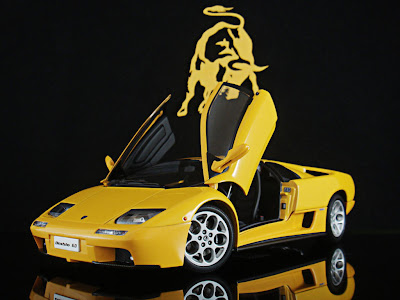The LP640 version was first shown at the Geneva Motor Show in March 2006, as a facelift for the coupé version. It features a 6.5 Liter engine, now producing 472 kW (642 PS/633 bhp), improving performance substantially. Like the base Murciélago, the engine is mounted "backwards", with the transmission in front of the engine and the differential behind it, instead of a transaxle normally seen on mid-engine cars. There were also a few minor external changes, primarily to the low air intakes.
The front and rear bumpers have been reshaped to channel air more efficiently, and the new exhaust has been shaped into the rear diffuser to minimize aerodynamic lift. The air intake on the left side has been enlarged to accommodate the feeding of the oil cooler. The car's body is made up of steel and carbon fiber, while underneath a revised suspension has been added to keep up with the car's performance. It also has an all-wheel-drive system that normally distributes 70% of the torque to the rear wheels, but can allocate up to 100% to either end depending on where the grip is running out. There are also new 18-inch (460 mm) Hermera alloy wheels running huge 335/30 tires at the rear. The LP640 retains the original car's scissor-opening doors.
Inside the LP640, the seating has been reshaped to accommodate greater headroom, while an upgraded instrument panel is flanked by an improved stereo system.
The LP640's optional equipment includes carbon ceramic brakes for swifter braking, chrome paddle shifters and a glass engine cover which shows off the LP640's engine.
A special edition version of the Murciélago LP640 was introduced at the Paris Motor Show. The Versace edition features a customized all-white exterior and a matching white interior. However, a one-of-a-kind black LP640 Versace and LP640 Roadster Versace were also presented by the factory.
LP stands for Longitudinale Posteriore, referring to the longitudinally-mounted, 6.5 L V12 engine, capable of producing up to 472 kW (642 PS/633 bhp) at 8000 rpm. Along with a new six-speed manual transmission, which can come in Lamborghini's optional paddle shift "E-gear" package, the LP640 can go from 0 to 100 km/h (62 mph) in just 3.3 seconds: 0.4 of a second quicker than the previous Murciélago, and reach a top speed of 219+ mph. The LP640 is accommodated by an electronic Launch control device called "Thrust."





Additional details:
- lowered front ride height (stock was oddly high)
- added reflector stickers for front-side fender lights (stock was missing)
- added carpet on the flooring
- repainted seatbelt lock buttons
- repainted some parts on the engine
- added chrome belt holders for hoses on the engine
- added wirings on the engine

















































































